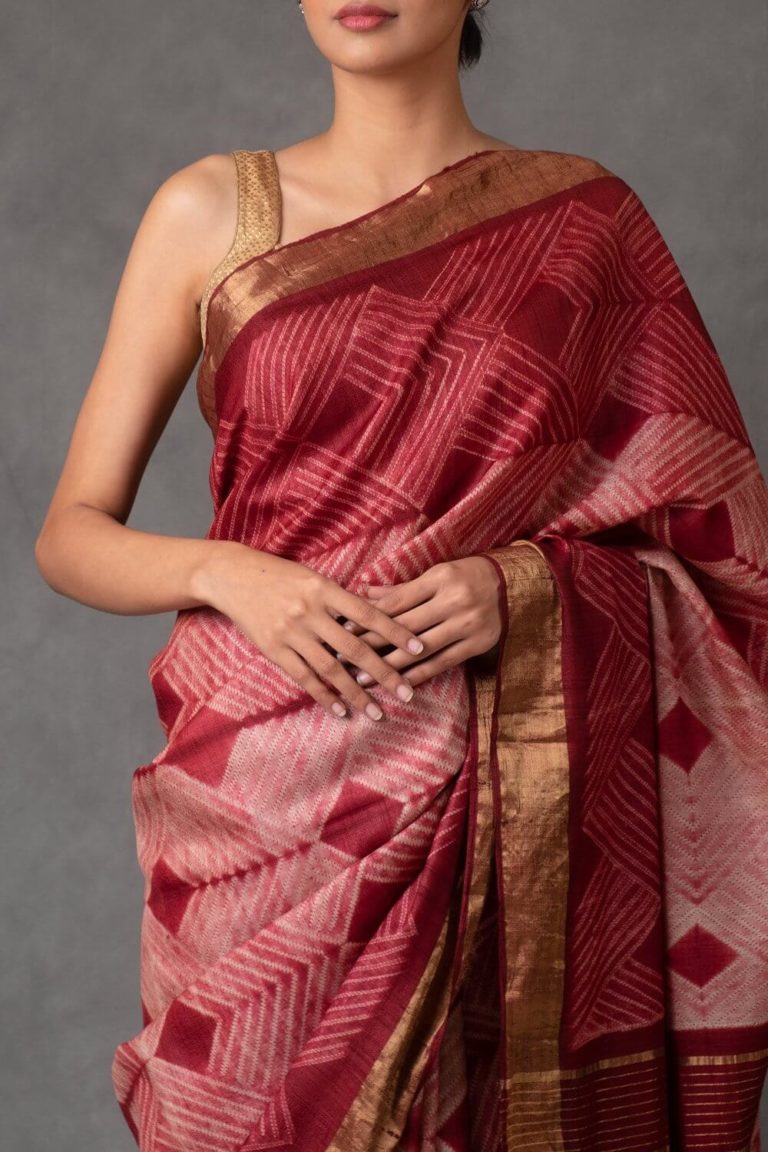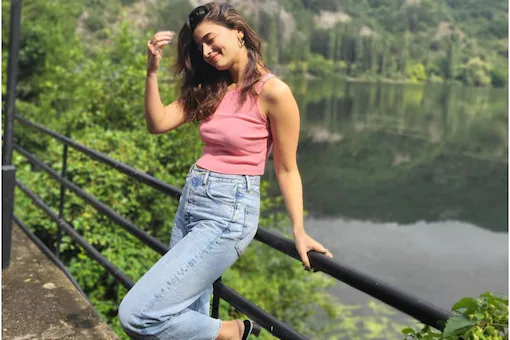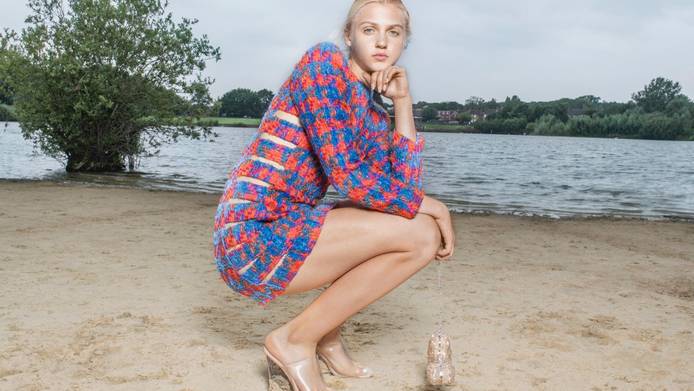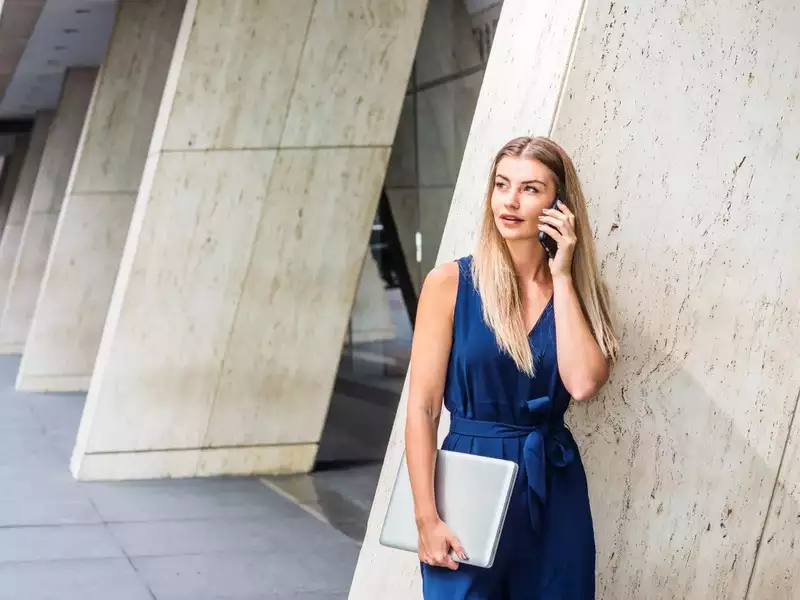What should I wear today? After waking up, it is probably the first question that crops up in your mind. We can’t solve this question for everyone, but we do have something for college girls. It is obvious that you cannot dress up all glamorous every day, so we bring some fashion choices inspired by Alia Bhatt which will make you appear absolute chic. There is no debate that Alia’s sartorial sensibilities have become more fashion-forward. From her gym athleisure to her airport looks, the 28-year-old actress is truly setting some fashion goals in millennial dressing.
As her wardrobe filled with the trendiest outfits on the block, here are the most stylish looks of the actress that will help you nail college fashion.
DENIMS
Denims are never out of fashion, and you can also try the denim-on-denim. This classic combination when paired with chunky white sneakers is a perfect look for college. Alia had once worn a pair of skinny jeans and paired it with an oversized two-tone jacket.
NEONS
One of the biggest trends to hit the fashion industry last year was the neon colour. From trench coats to jackets, and accessories, neons were in a raging trend. For the airport look, Alia had often opted for neon sweatshirts, cargo pants, and leather brogues.
TIE-DYE
Tie-Dye sweatshirts, pants, and dresses are ideal casual wear for college-goers. It just gives the uber-cool vibes, and Tie-Dye sweatshirts are very much present in Alia’s wardrobe too. Check out her multi-coloured co-ord tie-dye set.
BODYCON OR A-LINE DRESSES
If you want to add a glam quotient to your outfit, a bodycon or A-line dress is enough to do it.
CLASSIC KURTA
Whenever you are not able to decide what to wear, you can always count on traditional ensembles to save the day. Alia’s collection of A-line kurtas and anarkalis is every college girl’s dream.
https://www.news18.com/news/lifestyle/5-college-fashion-trends-inspired-by-alia-bhatt-that-you-must-try-4271186.html
Launched in 2009 the brand Injiri, meaning real India, focuses on textile development and sustainable usage of materials from across India which, perhaps more than any other country, has long supplied the fashion industry with extraordinary handwoven textiles. But how much do we really understand of these centuries-old techniques and what goes into the creation of them? In this interview Injiri founder Chinar Farooqui aims to help expand our knowledge of the artisan communities in her homeland where specific spots are known for particular techniques.
Injiri retails in 300 stores globally including landmark boutiques such as Dover Street Market in London and Japan, and ABC Home in NYC. It does not retail direct to consumer, and only 50 to 100 pieces are produced per style every season. This number does not reflect limitations of artisan resources, Farooqui explains, as there is an abundance of craftspeople in each sector. Instead it reflects her commitment to maintaining quality product as coordination can be challenging with artisans spread all across India.
Rethinking the fashion industry’s relationship with the artisans of India
Farooqui refers to the Injiri team as “a workshop of about 65 people,” but the foundation of the business is built upon her close working relationship with the keepers of the keys, India’s master weavers, embroiderers, and tie and dye artisans. Indifferent to trends she focuses on products that pay homage to slow-fashion, timeless luxury and ultimately, India’s heritage. She remarks how in days gone by woven material was a precious commodity to be used frugally and making clothes was a lengthy process. She says her contemporary aesthetic is often informed by the simplest of clothes worn by peasants, farmers, the common man.
Craft clusters across India are at the core of the brand’s success. Most of the textiles involve the collaboration of multiple individuals, usually all within a family, each having their area of expertise to bring the creations to life. Farooqui talks FashionUnited through the places behind the country’s most popular techniques, and the unique characteristics of craft clusters.
Jamdani from West Bengal
The Jamdani weave, known originally as the Dhakai, is one of the most time and labour-intensive forms of handloom weaving but is considered one of the finest varieties of muslin. First named after the city of Dhaka, one of many ancient textile weaving centers in the pre-partition Bengal region, it was under the Mughal Empire that the Persian term Jamdani became popular. The Jamdani consists of a supplementary weft technique of weaving, in addition to the standard weft that holds the warp threads together. The standard weft creates a fine, sheer fabric, while the supplementary weft with thicker threads adds intricate patterns. Each supplementary weft motif is added separately by hand by interlacing the weft threads into the warp with fine bamboo sticks using individual spools of thread. The pattern is not sketched or outlined on the fabric but is drawn on graph paper and placed underneath the warp. The result is a complex mix of different patterns that appear to float on a shimmering surface.
Chikankari from Lucknow, Madhya Pradesh
Translated from Urdu Chikankari simply means embroidery. Experts believe it evolved from the white-on-white embroidery of Shiraz that came to India as part of the culture of Persian nobles at the Mughal court. The delicate and artful hand embroidery technique involves working white thread onto cool, pastel shades of light muslin, cotton and silk. The time consuming process of creating a Chikankari piece can range from a few months to a few years due to the single needle work often done by women in between household chores. The pattern is first stamped onto the fabric by hand, then six basic stitches and over thirty-five other traditional stitches are used in various combinations based on the required pattern. The embroidery is often divided among the artisans, with groups of three or more specializing in one particular stitch. And, as each group finishes their part, the garment is passed on to the next group to add their speciality stitch.
Pochampally Ikkat from Andhra Pradesh
Originating in India’s silk city, Bodhan, the craft of Pochampally Ikkat involves dyeing silk thread and weaving it to create traditional geometric patterns in the Ikkat style. Iterations of Ikkat have long been a part of ancient Indian weaving traditions and have earned the Pochampally Ikkat a place on UNESCO list of world heritage sites for its iconic saree weaving clusters.
Traditionally woven in silk, a Pochampally Ikkat is time-consuming, passed down through families, and survives in a few villages mainly in the Nalgonda district in the state of Telangana. The warp, weft, or both are tie-dyed before weaving to create designs on the fabric and a process of wrapping determines the design. The warp threads are dyed and when unwrapped the areas under the ties have stayed the original color. Care must be taken when putting the warp on the loom to keep all the threads in position for the design to work.
Bhudoji Weaving from Gujarat
The Indian state of Gujarat has long been the entry point to the Indian sub-continent and a major trade and learning centre, with the sea on its left and a vast white desert on its right. Its people have been keepers of heritage crafts, one of which is the Bhujodi, named after its textile center.
Mughal migrants from Rajasthan over 500 years ago crafted the woolen veils and coarse woolen blanket for the Rabari community, to protect for the herdsmen out in the open fields. The blanket was worn either over the shoulder or around the waist and also as a turban. Their modern-day descendants use wool from local sheep, but the yarn, while in its raw form, breaks and gets entangled easily. So the woolen strands must be soaked before use in a thin paste of boiled wheat or rice flour, sun dried in the fields, and then separated by combing. Traditionally the men of the family do this while the women make the yarn on the charkha, laying it on the loom and finishing off the product with the iconic Abla embellishment.
Bandhani from Gujarat
The origins of Bandhani’s tie dye technique, also known as Bandhej, can be traced back to the Indus Valley civilization, one of the most ancient methods of patterning fabrics with the earliest example seen in 6th-century paintings of Buddha. The dye is prevented from reaching parts of the fabric through tying pinches of it, a process mainly done by women. For complex designs, blocks or tracing sheets with pinholes are used. Three basic tools are necessary for tying the Bandhani pattern: strong cotton thread, a glass pipe used to hold and tie the thread, and a thimble to pluck a tiny area to tie.
Tagai from Rajasthan
One of the many traditional crafts of Rajasthan is the Jaipuri Razai, the art of quilt making, traditionally made using hand-spun and handwoven khadi and hand-carded cotton filling. Born out of necessity, the cold winter nights in Rajasthan inspired people to quilt bed covers and the ancient process remains unchanged today. Dhunai, the carding, refers to the fluffing and cleaning of cotton done on a large wooden bow-like structure called a Pindar. Then a layer of the carded raw cotton is spread onto the stitched outer layer using hand and bamboo sticks. Finally it is flipped inside out and beaten to spread the cotton evenly, ready for the stitching process, done mainly by women, using basic running stitches of varying sizes.
https://fashionunited.uk/news/fashion/craft-clusters-how-one-sustainable-brand-uses-india-s-textile-heritage/2021092858021
The global fashion month is nearly halfway over, with several recurring themes and trends recurring across borders and fashion weeks. Here are the top 10 fashion trends as seen during New York and London Fashion Week:
1. Adaptive Fashion Hits the Runway
Since 2019 Adaptive Fashion has seen a rise in brands designing for the differently abled, with companies including Nike and Tommy Hilfiger championing and expanding their designs for disabilities. Runway fashion is catching up and this season saw models in wheelchairs take to the catwalks to show that innovative fashion can be truly inclusive. Faduma’s Fellowship in partnership with Oxford Fashion Studio showed being wheelchair-bound should not limit the joy of self-expression through fashion.
2. Colour
There is nothing like the hue of optimism, translated into a joyous use of colour which so far has seen a rainbow palette wash over the collections. From the jewel tones of Roksanda Ilincic at LFW, Norma Kamali’s vintage quilt prints and vibrant florals in NYC to master of the LBD Tom Ford, who is often resigned to a muted palette, but who’s opening look of vivid orange, glittering pink and azure blue stole the show.
3. Elevated Athleisure
The groutfit is out. No longer does activewear need to just be a sweatshirt and sweatpants. Designers are taking the athleisure trend and making it truly fashion. Essentials like the cargo pant or jeans worn with shrunken t-shirts or bra tops are the new uniforms of the street. Timeless wearability is a key factor making the fabric quality for sporty separates vital.
4. Artistic Prints
The prints seen on the runway this season were beautiful enough to frame and hang in a museum, from digitally enhanced graphics to sumptuous heritage quilts. Tie-dye even saw revolution in new ombré versions, where colours seems to seep and blend into the fabric. There was hot pink gingham seen as Prabal Gurung and an artistry of print at TSC Design House at Oxford Fashion Studio shown in London.
5. Hybrid Everything
Fashion weeks are hybrid. While September is traditionally the season for womenswear companies, menswear designers have taken to the catwalks too. Some brands are hosting digital shows, others in person, or revealing collections via film, like Victoria Beckham and Matty Bovan, the Woolmark Prize winner. In New York, Eckhaus Latta’s sensual knitwear made the point of being gender neutral. Designers are choosing which medium is right for them.
6. Spring Suits
The two-piece suit is making a comeback. Especially vibrant, colourful tailoring that makes a fashion statement. Suiting can be dressed up or down, but not to be confused with the grey business suit of the office uniform, instead tailoring is deconstructed and executed in subtle shades for a more modern take.
7. The Colour Purple
Already a key colour on the Pantone radar, shades of purple have been everywhere for the SS22 season. From mauve and lilac to lavender, grape and violet, spring is the season of all things purple. Wear it in full regalia or as punchy separates.
8. Gender-Free Looks
Gender is largely a social construct and designers are taking note and showcasing more fluid looks on the runway. In truly inclusive design, brands are keen to remove gender boundaries, featuring all kinds of body shapes and abilities. With the 90s trend revival set to stay, the oversized grunge looks emphasises youth culture by layering pieces any person can wear. This appeals to a customer who sees beyond the limitations of gender.
9. Sheer
Skin is in, with the little black dress shorter than ever, and a universal need to feel sexy again in clothing. Fabrics like tulle, chiffon, netting, mesh, lingerie and other see-thru options made a return to the catwalk. LVMH prize winner and London Fashion Week designer Nensi Dojaka was crowned the symbol of modern femininity by the Guardian with her fresh take on hosiery, bras and tiny dresses.
Cut-outs
Any shape is a go next season, as long as it can be cut, sewn and re-cut to dramatic effects. Designers are experimenting with asymmetric draping, knotting and twisting fabric in innovative new ways to show openings in a garment’s most unexpected places.
Trends collated in collaboration with The Riviere Agency
https://fashionunited.uk/news/fashion/10-trends-seen-on-the-fashion-week-catwalks-so-far/2021092357905
The pandemic has fundamentally changed how we engage with workwear. Pencil fit trousers, skirts, suits and shirts, which used to be the ultimate choice for workwear, have now completely vanished. Instead, workleisure is the latest in workwear as offices open up and employees head back to work.
Traditional office wear has seen a drop in takers over the last year and a half and workleisure trends have seen a growth. This means that elastic waistbands, flared pants, stretchable pants, shirtees, comfortable shoes etc are going to be number one in the back-to-office fashion list. So, here’s bringing to you five workleisure outfits that you can wear to work:
Shirtees
This is a combination of a shirt and T-shirt. “It can be worn for boardroom meetings as well as a quick coffee break. You can style it with flared pants and skirts and for footwear, you can opt for a classy pair of loafers,” says stylist Bakul Dutta.
Soft or slouchy suits
Meghan Markel was recently spotted wearing a maroon-coloured oversized pantsuit. It looked stunning and worked as an appropriate formal outfit. “Pantsuits in various comfortable materials and designs are a huge trend right now. Well-fitted suits now live in the past. Business casual outfits have a huge demand. So, you can sport a linen or silk pantsuit or even polyester, as long as you feel comfortable,” says fashion designer Jayati Chatterjee.
Silk blouse
Replace your starchy shirts with flowy silk and satin blouses. You can pair them up with jeans, skirts, trousers. “These blouses add the desired formal look that you need for the workplace and at the same time, they are comfortable,” says Jayati.
Micromodal trousers
Sweatpants aren’t the only comfortable pants that you can wear. A pair of elastic-waist micromodal stretchy trousers, in a more structured fabric and wide leg, offer the perfect compromise between leggings and traditional trousers.
Chic jumpsuit
When you love the comfort and coverage of having both a top and a pair of bottoms on, but you don’t have the time to mix and match your closet, the jumpsuit comes to the rescue. Like a dress, a jumpsuit can simply be slipped on and you have an instant outfit ready for work.
The nine days Indian festivity, Navratri has begun. This Indian Festival celebrates the triumph of good over evil.
Every day of the festival has a different significance because it honours Goddess Durga’s nine incarnations. It commemorates the Goddess’ victory over evil. A different auspicious colour is associated with each day of the festival, honouring the Goddess’ many incarnations. Wearing the appropriate colour on festive days will add to the celebration’s atmosphere, says Designer Kavita Gupta. Here are the nine colourful dresses suggestions of Navratri 2021 by her, so that you can enjoy the festivity in full elan.
Day 1
The first day of Navratri is dedicated to Maa Durga’s first incarnation, Goddess Shailputri, the mountain’s daughter. She represents strength and power as a feminine version of Mother Nature. Choose a grey that is somewhere between black and white in terms of colour temperature. Gorgeous ruffle lehenga will have you turning heads in grey. If there’s an embroidery or silver accent, it makes it even more appealing.
Day 2
Brahmacharni is revered on the second day. Mark her arrival in wearing the newest drapery styles. Allow the flowing layered drapes to transform your look into something seductive. For the perfect dandiya night look, pair an A-Line Kurta with a long jacket. It’s also less cluttered because there are no dupattas, and it draws attention to the women’s figures.
Day 3
Devi Chandraghanta, the goddess with the half-moon on her forehead, is honoured on this day. Nothing compares to the timeless elegance of a white Kurti paired with a phulkari or bandhej dupatta. Wear this with oxidized silver jewellery for the dandiya night to look stunning.
Day 4
The fourth day is devoted to the Goddess Khushmanda so welcome her by dressing up in a red saree. A red saree is a must-have for any Indian woman’s wardrobe. However, wearing a red ruffle saree will draw attention to you on a festive night.
Day 5
Day five of Navratri is for Goddess Skandamata. Please her with a royal blue hue. The colour royal blue is associated with aristocracy and looks stunning on people of all skin tones. Our Navratri Dandiya Raas Lehenga Choli with Dupatta will put you in the mood for Garbha right away. Makeup, silver jewellery, and festive flair will all brighten your festive spirits.
Day 6
Celebrate the sixth day in worshipping Goddess Katyayani, the sixth incarnation. Wear marigold yellow, which is an auspicious colour for Indian celebrations because of its meaning. There are numerous trendy ways to wear a bright and cheery colour. Bring the modern look to your wardrobe by wearing an asymmetrical flared kurta with foil prints. Indulge in glitzy golden metallic prints for a glimmering look.
Day 7
Kaalratri is worshipped on the seventh day of Navratri or Saptami. Enjoy this day with spirit in this season’s fashion trend for voluminous sleeves. Wear a dress with oversized sleeves to make a statement. Turn all eyes on yourself in this vintage-inspired bell-sleeve kurta. Aside from that, the stunning shade of green will instantly elevate your style game.
Day 8
Goddess Mahagauri, the eighth manifestation of Durga, is worshipped on the eighth day. Embroideries have always been a major fashion trend, no matter what time it is. Each one is unique and adds a fun, carefree vibe to your ensemble. Choose a soft Lucknowi saree or kurta in Peacock Green. Adding extra sequins or zari in a soothing colour for Navratri will enhance the charm.
Day 9
Spend the ninth day of Navratri in adoration of Goddess Siddhidhatri. Kurtas with a modest and clean-cut receive a festive makeover. Opt for a traditional purple kurta that’s been given a modern makeover. There’s a funky vibe to the embroidery at the top and bottom of the shirt. Your Navratri wardrobe will look effortlessly stylish with this Side Split Long Flared Anarkali Suit.
https://www.india.com/lifestyle/navratri-2021-bring-out-your-inner-fashion-diva-with-these-fashion-tips-5047688/
There is no dearth of fabulous Jewellery design trends that catch every ethnic loving fashionista’s attention. Some make you look like a walking Jewellery store and then there are those kinds that make you wonder, if you are wearing any! Are you on a treasure hunt for bling-tastic jewels that work well with any outfit; suit every occasion; are show stoppers in every sense of the word? Come, we’ve unearthed all the right kinds of Jewellery designs for you, just in time for the wedding season!
You know what they say about good things coming in small packages? Well, this traditional Rajwadi Jhumki earrings define exactly that!
Oxidised Opulence
A Jewellery design set like no other, this one will set your Navratri outfit on a roaring, fashionable fire! This set is the perfect blend of chunk meets charm, don’t you think?
Moonlit Magnificence
A box full of Jewellery designs is incomplete without a resplendent pair of Chandbalis that could give Deepika Padukone’s Leela, a run for her money, isn’t it?
Silver Shimmer
Simple sophistication is the one quality that always makes you stand out. Sport this with any ensemble of your choice: ethnic or western and let this piece’s charm elevate your style status!
Temple Tales
Trendy Temple Jewels will always keep you ahead of even the most stylish fashionistas! Change your ethnic game as you stock up on this traditional shine staple.
Pendant Power
Suffering from the usual i-have-nothing-to-wear woes? Fret not, this perfect piece of oxidised wonder is here to free you from any kind of style slumps!
6-String Stunner
It is time you feel like the goddess you truly are. A long layered necklace coupled with exquisite Jhumkis, is a a festive essential, perfect for the Silk Saree that you have already thought to wear!
Mesmerizing Must-have
Remember how you always wanted a Crown? Well, here is one from our box of jeweled wonders! A mathapatti styled Maang Tika will take you one step closer to having the most coveted casket of jewllery essentials.














